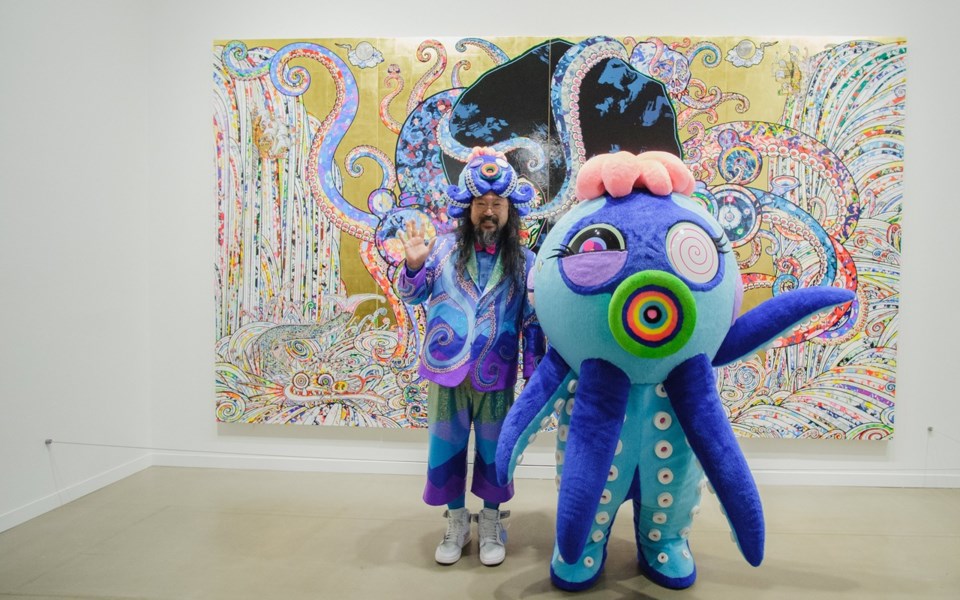At Bar Oso, they serve it as a tapas "Jorge" style (for chef Jorge Muñoz Santos), the octopus starring in a simple and singular role after being cooked sous-vide in a long, slow luxurious hot-water bath, finished with delicious olive oil, garlic and paprika and served with confit potatoes.
At Caramba! Restaurant and Sushi Village, Mr. or Ms. Octopus, for both are eaten equally, also starts out in a special water-bath cooker. (How about some 12 hours slowly cooking at 72 degrees!)
But first, at Caramba, it's marinated in good olive oil, lemon, garlic, thyme, rosemary and a smash of lemon rinds then vacuum-packed in this "nectar" before enjoying its watery bath, which echoes the sea from which it's come. Once it's out of its tenderizing bath, the octopus — or pulpo in Spanish — is char-grilled and served with a pickled garlic potato puree, white cannellini beans (a fave of chef James Pare), signature air-dried chorizo Caramba founder Mario Enero was known for, and salsa habanera. Yum.
At Sushi Village, of course, we ultimately find post-water-bath octopus or tako, as it's called in Japanese, in multiple forms: in sushi, sunomono salad and takoyaki, those delicious little fried octopus balls that originated in Osaka. This popular Japanese street food is made with egg, flour, chopped green onion and dashi, and served with special sauce and bonito flakes.
With so many delicious octopus dishes around, and a number of sources of this seafood quite sustainable (ask your server, for it's complicated but Ocean Wise has certified a few, including B.C. and Alaska's giant Pacific octopus caught in pots and traps, both the night and day octopus harvested by handline and spear in Hawaii, and the common octopus caught in pots in Spain and Portugal), I have to wonder why more Canadians don't try it.
It might be because of the powerful, mysterious and sometimes forbidding mythology surrounding the animal. With its many strange arms, ink-blasting capabilities, ugly beak and ability to morph into all kinds of unusual shapes, colours and even skin textures (remember Inky, who famously and nimbly escaped the New Zealand aquarium in 2016?) octopuses — or octopi, although the former is now favoured as the modernized plural — have represented everything from Medusa's chopped off head in Greek mythology to Akkorokamui, the giant and terrifying octopus-like monster in the Ainu folklore of Japan. Octopuses are even at the heart of a booming tentacle erotica genre.
"They (Canadians) imagine tako looks gross," says Keisuke Matsuzaki, chef and kitchen manager at Sushi Village, who was hired by the late, great Miki Homma.
Like most people in the Chiba area near Tokyo where he grew up, Matsuzaki ate lots of tako in Japan, where it's simply accepted as one of many different types of food to choose from.
"It's a strange animal, so they don't like touching," he says, then laughs.
"It looks weird — like an alien from space!"
Despite its ubiquity — there are some 300 species of octopus found all over the world — here on the "Wet" Coast we still usually think of octopus as some kind of alien food and aren't usually prepared to even try it. But maybe, just maybe, our talented chefs are changing all that. When it comes to octopus, Caramaba's Pare says things are in flux.
"People in North America are becoming a little more aware of what's out there, a little more aware of what good food tastes like as well, and tasting different things, so I think a transition is happening," says Pare, who grew up in Chilliwack and laughs when he recalls trying his first sushi decades ago at age 19 at — you guessed it — Homma's at Sushi Village.
"Venture out! Do it!" Pare urges about trying octopus. "After all, what have you got to lose?"
Indeed. You can broaden your tastes at the table, and in art — and use the mighty octopus as your gateway.
Right now, the Vancouver Art Gallery is featuring a delicious cultural offering. Called The Octopus Eats its Own Leg, referring to the trope of an octopus, or any trapped creature, biting off its own leg to save its life, the show covers decades of Takashi Murkami's influential work, including huge 3D pieces and a number of powerful 2D pieces that beautifully demonstrate his accomplished technique. After all, he was originally trained in nihonga, a style that arose in Japan around the early 1900s and is based on traditional Japanese approaches more than a thousand years old.
Beautiful technique aside, Murakami is best known for starting and popularizing superflat — the hip, powerful 2D art style that sprang from Japan's anime and manga art and cracked open high/low, East/West cultural boundaries. His work has shown up everywhere, from Kanye West album covers and graffiti and snowboarder art to Louis Vuitton purses. And his influence just keeps morphing and growing.
Murakami's superflat is as mysterious and changeable as the octopus itself. It can take on any number of forms, from sexualized ones to playful or powerful mythological ones, all reinterpreted for a postmodern world discovering new possibilities and hungry for mystery.
Bonus: this VAG show is a rare treat. It's the first big retrospective of Murakami's work in Canada, so venture out — do it! — before it escapes May 3 to Chicago and beyond.
What have you got to lose?
Glenda Bartosh is an award-winning journalist who often wishes she had more than one arm when she's in her art studio. She now writes in this space every other week.




